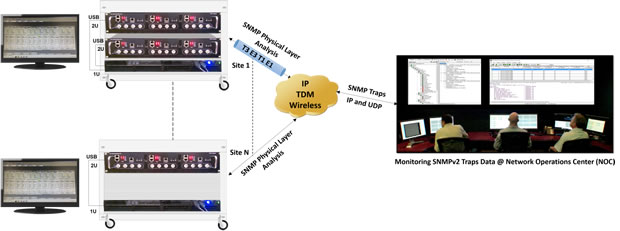T3 E3/T1 E1 Analyser enhanced with SNMP trap notification
The enhanced T3 E3/T1 E1 Analyser with Rackmount version that includes T3 T1 Physical Layer Analyser and SNMP Trap Notification has been announced by GL Communications.
Vijay Kulkarni, the CEO of GL Communications said: “A T3 line is an ultra-high-speed signal capable of transmitting data at rates up to 44.736Mbps. An E3 signal is situated at the third level within the Plesiochronous Digital Hierarchy (PDH) and has a bit rate of 34.368Mbps. With the advent of the internet, T3 (DS3) and E3 can be used to transport not only data, but also packetised voice, and packetised video. Example protocols include Asynchronous Transfer Mode (ATM), PPP, HDLC, and Frame Relay.”

He added: “GL’s enhanced T3 E3/ T1 E1 Analyser is now available in 2U Rackmount platform. The Rack unit supports 6 T3 E3 ports (6 * 672 DS0s) per unit, whereas a portable USB-based unit supports 2 T3 E3 ports per unit. Multiple rack units can be stacked together for greater scalability.”
Kulkarni further explained: “The enhanced T3 E3 Analysis software complements the hardware and supports simultaneously monitoring up to 12 x T3 E3 lines (2x Rack units or 6x Portable units) for all alarms, frame errors, signalling and data. For monitoring provisioned DS0s on a channelised T3, one just adds the Channelised T1 E1 Analysersoftware to the system. Then the T1s within the T3s can also be analysed in software, 12 x T3 E3 lines (=12*28 T1s) constituting 336 full duplex T1s, or 672 simplex T1s monitored simultaneously using a single Rack unit. With additional applications, such as record-only, one can also record traffic at DS0 levels.”
He concluded: “The enhanced USB T3 E3 Analysis software, also comes with T3 T1 Physical Layer Analyser system that monitors all physical layer ‘T3s’ and ‘T1s’ within the ‘T3s’ connected to it via monitor level (non-intrusive - 20 dB attenuated) T3 signals. Alarms monitored at the DS3 level and at the DS1 level are packetised and sent via TCP/IP to central database, these alarms can also be sent in the form of SNMPv2 Traps via Simple Network Management Protocol (SNMP) to network operation centre.”


